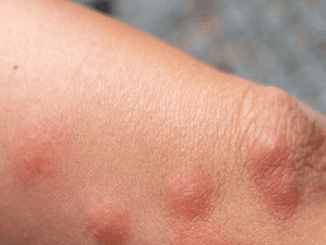Dark circles under the eyes are often blamed on lack of sleep, and while that’s certainly one cause, it’s far from the only explanation. In fact, many well-rested people still experience dark circles due to a variety of factors that can lead to periorbital hyperpigmentation (POH). If you’ve been wondering why you still have dark circles despite getting enough shut-eye, here are eight other potential reasons—and what you can do about them.

Source: Shutterstock
1. Dehydration – A Common Cause with a Simple Fix
Dehydration is a frequent culprit when it comes to dark circles under the eyes. When your body doesn’t get enough water, your skin can become dull and your eyes may look sunken, emphasizing dark circles. The area around the eyes is particularly sensitive to dehydration because the skin there is so thin.
What to do: The good news is that this cause is easily reversible. Make sure you’re drinking plenty of water—aim for at least 8 glasses a day. Incorporate hydrating foods into your diet, such as watermelon, cucumbers, and soups, to keep your skin looking fresh and plump.
2. Anemia – Low Iron Levels Affecting Skin Color
Anemia, specifically iron-deficiency anemia, can cause dark circles. This condition occurs when your body doesn’t have enough red blood cells or hemoglobin to transport oxygen effectively. As a result, your skin can become pale, making dark eye circles more prominent.
What to do: Anemia is typically diagnosed with a blood test. If you suspect you have anemia, visit a healthcare professional for a proper diagnosis. Treatment often includes iron supplements and dietary changes to boost iron intake, with foods like spinach, red meat, and fortified cereals.
3. Allergies – Histamine Reactions Causing Dark Circles
Allergies can cause more than just sneezing and itchy eyes—they can also contribute to dark circles. When your body reacts to allergens, it releases histamines, which can cause inflammation, itching, and swelling around the eyes. The constant rubbing and scratching of the eyes can exacerbate the issue, causing blood vessels to break and darken the skin.
What to do: Managing allergies with antihistamines or allergy treatments can help reduce the occurrence of dark circles. Avoid rubbing your eyes, as this can further damage the delicate skin around them.
4. Sun Overexposure – Melanin Leading to Hyperpigmentation
While everyone enjoys a bit of sun, overexposure can lead to dark circles. The sun stimulates your body to produce more melanin, the pigment responsible for tanning, but this can also cause dark patches under the eyes if the pigmentation occurs unevenly.
What to do: To prevent sun-induced dark circles, always wear sunscreen, even on cloudy days. You can also wear sunglasses and wide-brimmed hats for extra protection against harmful UV rays.
5. Skin Conditions – Dermatitis and Eczema Aggravating Dark Circles

Source: Shutterstock
Certain skin conditions, such as eczema or contact dermatitis, can cause inflammation and dilate the blood vessels under the eyes, making them more visible. The irritation from these conditions often leads to rubbing or scratching, which can worsen the appearance of dark circles.
What to do: If you suffer from eczema or dermatitis, consult a dermatologist for treatments to reduce inflammation. Over-the-counter hydrating creams and prescribed medications can help manage these skin conditions and alleviate dark circles.
6. Eyestrain – Overworking Your Eyes Can Lead to Circles
In our digital world, eyestrain is becoming increasingly common, whether from staring at screens, reading, or even driving for long periods. Prolonged eyestrain can cause the blood vessels around your eyes to enlarge, leading to dark circles and a tired appearance.
What to do: The best way to prevent eyestrain is to follow the 20-20-20 rule: every 20 minutes, look at something 20 feet away for at least 20 seconds. Ensure proper lighting in your environment and take regular breaks to reduce strain on your eyes.
7. Age – Natural Changes Leading to Thinning Skin

Source: Shutterstock
As we age, the skin around the eyes naturally becomes thinner, making blood vessels more noticeable and increasing the appearance of dark circles. The aging process also causes a loss of fat and collagen, which can further contribute to the problem by deepening tear troughs and creating shadows under the eyes.
What to do: While aging can’t be avoided, you can reduce the appearance of dark circles with hydrating eye creams, serums containing retinoids or hyaluronic acid, and using cold compresses to minimize puffiness. Consider professional treatments like laser therapy or fillers if the issue becomes particularly bothersome.
8. Genetics – Hereditary Causes of Dark Circles
Sometimes, dark circles are simply hereditary. If your family members have dark circles under their eyes, you might be more prone to them too. This is often due to the natural structure of the face or skin tone, as some people naturally have more prominent tear troughs or pigmentation in the lower eyelid area.
What to do: While you can’t change your genetics, you can minimize the appearance of dark circles with regular skincare routines, including moisturizers and sunscreens. Cosmetic procedures such as fillers can also help reduce the visibility of hereditary dark circles.
How to Prevent and Reduce Dark Circles

Source: Shutterstock
While not all causes of dark circles can be avoided, there are plenty of methods you can use to reduce their appearance:
- Cold Compresses: Applying a cold compress can shrink blood vessels and reduce puffiness, making dark circles less noticeable.
- Caffeinated Tea Bags: The caffeine in tea bags can help stimulate blood circulation and shrink blood vessels, reducing dark circles.
- Cucumber Slices: Known for their hydrating and anti-inflammatory properties, cucumber slices can soothe the skin and minimize puffiness.
- Sun Protection: Always use sunscreen around your eyes and wear sunglasses to protect the delicate skin from UV damage.
- Hydration: Keep yourself well-hydrated and avoid salty or processed foods that can cause fluid retention and puffiness.
- Quit Smoking and Limit Alcohol: Smoking and drinking alcohol can exacerbate dark circles by dehydrating the skin and reducing circulation.
- Moisturizers: Invest in a quality eye cream with ingredients like retinol, vitamin C, or hyaluronic acid to keep the skin around your eyes nourished.
Conclusion: Dark Circles Aren’t Just About Sleep
Although lack of sleep is a common cause, dark circles under the eyes can be influenced by many other factors, including dehydration, genetics, allergies, and aging. Understanding the root cause of your dark circles is the first step toward finding the right solution. Whether it’s adjusting your skincare routine, improving your hydration levels, or seeking medical advice, there are many ways to reduce the appearance of dark circles and keep your skin looking fresh and healthy.
By identifying and addressing the underlying issues, you can minimize the appearance of dark circles and enjoy a brighter, more refreshed look.


